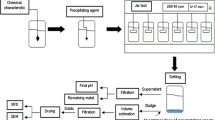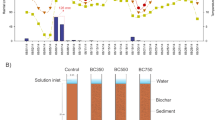Abstract
In the recent years, steelmaking slag is attracting attention as suitable materials for restoration of estuary ecosystems. However, there is concern about solidification when the material is applied to create seagrass beds. In this study, dephosphorization slag (DePS) was immersed into seawater for 10 months to examine the solidification processes and its mechanisms to control the strength of solidification. The hypothesis in this study is that solidification could be alleviated by adding dredged soil to the DePS. After 5 months of immersion, the shear strength of the DePS increased from 1.8 to 5.0 kN/m2; however, its shear strength decreased significantly to 3 kN/m2 after 10 months. Furthermore, after 5 months, reddish color was observed on the surface of the DePS, whereas the color of the surface of the DePS turned black at 7 months under reducing condition with covering by mud. To validate the results, we carried out an additional study, in which the DePS was immersed in seawater, and the solidified DePS was subsequently treated with Na2S; the increase and decrease of the shear stress of DePS were reproduced. The solidified DePS before and after exposure to reducing conditions was also analyzed using a combination of microanalysis with an electron probe and Mössbauer spectroscopy. These analyses showed that the solidification was caused by the formation of bridges that composed of iron oxyhydroxides, whereas the subsequent embrittlement of the solidified DePS was attributed to changing in the chemical species of iron.







Similar content being viewed by others
References
Akiyama Y, Yano H, Asaoka S, Okuda T, Nakai S, Nishijima W (2015) Evaluation of steelmaking slag as basal media for coastal primary producers. Mar Pollut Bull 100:240–248
Asaoka S, Yamamoto T, Yoshioka I, Tanaka H (2009) Remediation of coastal marine sediments using granulated coal ash. J Hazard Mater 172:92–98
Asaoka S, Okuda T, Nakai S, Nishijima W (2013) Determination method for maximum calcium releasing potential from steel slags, marine sands alternatives in seawater. ISIJ Int 53:1888–1893
Astera M (2014) The ideal soil: a handbook for the new agriculture. 2nd edn. Agricola***
Backnaes L, Stelling J, Behrens H, Goettlicher J, Mangold S, Verheijen O, Beerkens RGC, Deubener J (2008) Dissolution mechanisms of tetravalent sulphur in silicate metals: evidence from sulphur K edge XANES studies on glasses. J Am Cera Soc 91:721–727
Blanchet H, Montaudouin X, Lucas A, Chardy P (2004) Heterogeneity of macrozoobenthic assemblages within a Zostera noltii seagrass bed: diversity, abundance, biomass and structuring factors. Estuar Coast Shelf Sci 61:111–123
Edgar GJ, Shaw C (1995) The production and trophic ecology of shallow-water fish assemblages in southern Australia III: general relationships between sediments, seagrasses, invertebrates and fishes. J Exp Mar Biol Ecol 194:107–131
Frankignoulle M, Bouquegneau JM (1990) Daily and yearly variations of total inorganic carbon in a productive coastal area. Estuar Coast Shelf Sci 30:79–89
Frost JD, Han J (1999) Behavior of interfaces between fiber-reinforced polymers and sands. J Geotech Geoenviron Eng 125:633–640
Gambi MC, Nowell ARM, Jumars PA (1990) Flume observations on flow dynamics in Zostera marina (eelgrass) beds. Mar Ecol Prog Ser 61:159–169
Harvey OR, Harris JP, Herbert BE, Stiffler EA, Haney SP (2010) Natural organic matter and the formation of calcium-silicate-hydrates in lime-stabilized smectites: a thermal analysis study. Thermochim Acta 505:106–113
Hayakawa S, Hajima Y, Qiao S, Namatame H, Hirokawa T (2008) Characterization of calcium carbonate polymorphs with Ca K edge X-ray adsorption fine structure spectrometry. Anal Sci 24:835–837
Hayashi A, Tozawa H, Shimada K, Takahashi K, Kaneko R, Tsukihashi F, Inoue R, Ariyama T (2011) Effects of the seaweed bed construction using the mixture of steelmaking slag and dredged soil on the growth of seaweeds. ISIJ Int 51:1919–1928
Hayashi A, Asaoka S, Watanabe T, Kaneko R, Takahashi K, Miyata Y, Kim K, Yamamoto T, Inoue R, Ariyama T (2014) Mechanism of suppression of sulfide ion in seawater using steelmaking slag. ISIJ Int 54:1741–1748
Haynes RJ (2015) Use of industrial wastes as media in constructed wetlands and filter beds-prospects for removal of phosphate and metals from wastewater streams. Cri Rev Environ Sci Technol 45:1041–1103
Hendriks I, Sintes T, Bouma T, Duarte C (2008) Experimental assessment and modeling evaluation of the effects of the seagrass Posidonia oceanica on flow and particle trapping. Mar Ecol Prog Ser 356:163–173
Hizon-Fradejas AB, Nakano Y, Nakai S, Nishijima W, Okada M (2009a) Evaluation of blast furnace slag as basal media for eelgrass bed. J Hazard Mater 166:1560–1566
Hizon-Fradejas AB, Nakano Y, Nakai S, Nishijima W, Okada M (2009b) Anchorage and resistance to uprooting of eelgrass (Zostera marina L.) shoots planted in slag substrates. J Water Environ Technol 7:91–101
Hizon-Fradejas AB, Nakano Y, Nakai S, Nishijima W, Okada M (2010) Utilizing dredged sediment for enhancing growth of eelgrass in artificially prepared substrates. World Acad Sci Eng Technol 71:116–121
Kamimura T, Nasu S, Tazaki T, Kuzushita K, Morimoto S (2002) Mössbauer spectroscopic study of rust formed on a weathering steel and a mild steel exposed for a long term in an industrial environment. Mater Trans 43:694–703
Kim K, Asaoka S, Yamamoto T, Hayakawa S, Takeda K, Katayama M, Onoue T (2012) Mechanisms of hydrogen sulfide removal with steel making slag. Environ Sci Technol 46:10169–10174
Kim K, Hibino T, Yamamoto T, Hayakawa S, Mito Y, Nakamoto K, Lee I (2014) Field experiments on remediation of coastal sediments using granulated coal ash. Mar Pollut 83:132–137
Kim H, Kim K, Jung S, Hwang I, Choi J, Sohn I (2015) Valorization of electric arc furnace primary steelmaking slags for cement applications. Waste Manag 41:85–93
Li H, Matsunaga N, Takino T (2009) Investigation on biochemical environments of seabed in Isahaya Bay. Annu J Hydraul Eng 53:1501–1506
Mckeown DA, Muller IS, Gan H, Pegg IL, Stolte WC (2004) Determination of sulfur environments in borosilicate waste glasses using X-ray absorption near-edge spectroscopy. J Non-Cryst Solids 333:74–84
Miki O, Ueki C, Kato T (2013) Control of sulfide release from bottom sediments at borrow pits using steelmaking slag. J Water Environ Technol 11:101–110
Millero FJ, Yao W, Aicher J (1995) The speciation of Fe(II) and Fe(III) in natural waters. Mar Chem 50:21–39
Ministry of the Environment, Japan (2013) The information of natural environment (In Japanese). http://www.env.go.jp/water/heisa/heisa_net/setouchiNet/seto/kankyojoho/sizenkankyo/moba_higata.htm
Motz H, Geiseler J (2001) Products of steel slags an opportunity to save natural resources. Waste Manag 21:285–293
Nagai T, Miki O, Okumura C (2014) Effects of chelated iron on the growth of Sargassaceae species at the germling and immature stages. J Water Environ Technol 12:285–294
Nasu S (2005) Mössbauer spectroscopy of rust on steels (in Japanese). Corros Eng 54:45–52
Nishijima W, Tsukasaki A, Tanimoto T, Nagao M, Tsurushima N, Suzumura M (2015a) Applicability of steel slag as a substrate in eelgrass (Zostera marina L.) beds restoration in coastal Japan. Ecol Eng 81:418–427
Nishijima W, Nakano Y, Hizon-Fradejas AB, Nakai S (2015b) Evaluation of substrates for constructing beds for the marine macrophyte Zostera marina L. Ecol Eng 83:43–48
Okuda T, Asaoka S, Yano H, Yoshitsugu K, Nakai S, Nishijima W, Sugimoto K, Matsumani D, Asaoka Y, Okada M (2014) Chemical behavior of sand alternatives in the marine environment. Chemosphere 111:164–168
Okumiya E, Kuwae T, Hagimoto Y, Konuma S, Miyoshi E, Nomura M, Nakamura Y (2001) Relationships between sedimentary strength and environmental factors in intertidal flats: experiments by using Cone Penetration Tests (in Japanese). Port Airport Res Inst 1002:1–22
Rayner-Canham G, Flynn C (2010) Iron ocean seeding. Educ Chem 47:140–143
Takeoka H (2002) Progress in Seto Inland Sea research. J Oceanogr 58:93–107
Tamaki H, Tokuoka M, Nishijima W, Terawaki T, Okada M (2002) Deterioration of eelgrass, Zostera marina L., meadows by water pollution in Seto Inland Sea, Japan. Mar Pollut Bull 44:1253–1258
Tanner JE (2015) Restoration of the seagrass amphibolis antarctica-temporal variability and long-term success. Estuar Coasts 38:668–678
Terawaki T, Shimaya M, Moriguchi A (2005) Excellent examples of eelgrass Zostera marina bed restoration continuing along the coast of Seto Inland Sea, Japan (in Japanese). Jpn Soc Fish Eng 42:151–157 (In Japanese with English abstract)
Terrados J, Duarte C, Kamp-Nielsen L, Agawin NS, Gacia E, Lacap D, Fortes M (1999) Are seagrass growth and survival constrained by the reducing conditions of the sediment? Aquat Bot 65:175–197
Tsai CJ, Huang R, Lin WT, Wang HN (2014) Mechanical and cementitious characteristics of ground granulated blast furnace slag and basic oxygen furnace slag blended mortar. Mater Des 60:267–273
Whitehouse SJR, Bassoullet P, Dyer RK, Mitchener JH, Roberts W (2000) The influence of bedforms on flow and sediment transport over intertidal mudflats. Cont Shelf Res 20:1099–1124
Yamada H, Kayama M, Saito K, Hara M (1987) Suppression of phosphate liberation from sediment by using iron slag. Water Res 21:325–333
Yamamoto M, Fukushima M, Liu D (2012) The effect of humic substances on iron elution in the method of restoration of seaweed beds using steelmaking slag. ISIJ Int 52:1909–1913
Yano H, Nakai S, Okuda T, Nishijima W (2015) Sediment environment of an artificial tidal flat constructed using carbonated decarburization slag and dredged soil (in Japanese). Environ Sci 28:405–414
Zhou Y, Liu X, Liu B, Liu P, Wang F, Zhang X, Yang H (2015) Unusual pattern in characteristics of the eelgrass Zostera marina L.in a shallow lagoon (Swan Lake), north China: implications on the importance of seagrass conservation. Aquat Bot 120:178–184
Acknowledgments
The authors thank JFE Steel Co., Japan, for providing samples and sharing information. Experiments at HiSOR were carried out under the approval of the HSRC Program Advisory Committee (#:14-A-12). This research was partially supported by Environment Research and Technology Development Fund granted by the Ministry of the Environment, Japan (F1102 and S-13) and the Steel Foundation for Environmental Protection Technology. We thank Dr. Shibata and Dr. Issako, the N-BARD, Hiroshima University for the EPMA measurements.
Author information
Authors and Affiliations
Corresponding author
Electronic supplementary material
Below is the link to the electronic supplementary material.
Rights and permissions
About this article
Cite this article
Yano, H., Okuda, T., Nakai, S. et al. Mechanisms of solidification and subsequent embrittlement of dephosphorization slag used in a subtidal zone as an alternative to sea sand and prevention of solidification by adding dredged soil. Clean Techn Environ Policy 18, 1167–1176 (2016). https://doi.org/10.1007/s10098-016-1110-6
Received:
Accepted:
Published:
Issue Date:
DOI: https://doi.org/10.1007/s10098-016-1110-6




